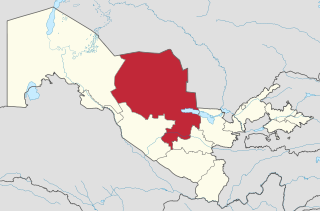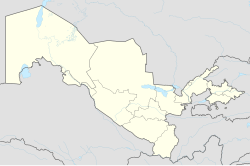
Uzbekistan, officially also the Republic of Uzbekistan, is a landlocked country in Central Asia. The sovereign state is a secular, unitary constitutional republic, comprising 12 provinces, one autonomous republic, and a capital city. Uzbekistan is bordered by five landlocked countries: Kazakhstan to the north; Kyrgyzstan to the northeast; Tajikistan to the southeast; Afghanistan to the south; and Turkmenistan to the southwest. Along with Liechtenstein, it is one of the world's only two doubly landlocked countries.
In the first millennium BC, Iranian nomads established irrigation systems along the rivers of Central Asia and built towns at Bukhara and Samarqand. These places became extremely wealthy points of transit on what became known as the Silk Road between China and Europe. In the seventh century AD, the Soghdian Iranians, who profited most visibly from this trade, saw their province of Transoxiana (Mawarannahr) overwhelmed by Arabs, who spread Islam throughout the region. Under the Arab Abbasid Caliphate, the eighth and ninth centuries were a golden age of learning and culture in Transoxiana. As Turks began entering the region from the north, they established new states, many of which were Persianate in nature. After a succession of states dominated the region, in the twelfth century, Transoxiana was united in a single state with Iran and the region of Khwarezm, south of the Aral Sea. In the early thirteenth century, that state was invaded by Mongols, led by Genghis Khan. Under his successors, Iranian-speaking communities were displaced from some parts of Central Asia. Under Timur (Tamerlane), Transoxiana began its last cultural flowering, centered in Samarqand. After Timur the state began to split, and by 1510 Uzbek tribes had conquered all of Central Asia.
The Uzbeks are a Turkic ethnic group; the largest Turkic ethnic group in Central Asia. They comprise the majority population of Uzbekistan but are also found as a minority group in Afghanistan, Tajikistan, Kyrgyzstan, Kazakhstan, Turkmenistan, Russia and China. Uzbek diaspora communities also exist in Turkey, Saudi Arabia, and Pakistan.
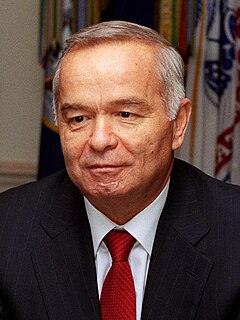
Islam Abduganiyevich Karimov was the leader of Uzbekistan and its predecessor state, the Uzbek Soviet Socialist Republic, from 1989 until his death in 2016. He was the last First Secretary of the Communist Party of Uzbekistan from 1989 to 1991, when the party was reconstituted as the People's Democratic Party of Uzbekistan (PDP); he led the PDP until 1996. He was the President of the Uzbek SSR from 24 March 1990 until he declared the independence of Uzbekistan on 1 September 1991.

The Islamic Movement of Uzbekistan was a militant Islamist group formed in 1998 by the Islamic ideologue Tahir Yuldashev, and former Soviet paratrooper Juma Namangani—both ethnic Uzbeks from the Fergana Valley. Its original objective was to overthrow President Islam Karimov of Uzbekistan, and to create an Islamic state under Sharia; however, in subsequent years, it reinvented itself as an ally of Al-Qaeda and the Taliban. In mid-2015 its leadership publicly pledged allegiance to the Islamic State of Iraq and the Levant (ISIL) and announced that the IMU was part of the group's regional branch. Dissident elements of the IMU retained the group's name and their alliance with al-Qaeda and the Taliban.

Uzbekistan is the common English name for the Uzbek Soviet Socialist Republic and later, the Republic of Uzbekistan, that refers to the period of Uzbekistan from 1924 to 1991. as one of the constituent republics of the Soviet Union. It was governed by the Uzbek branch of the Soviet Communist Party, the only legal political party, from 1925 until 1990. From 1990 to 1991, it was a sovereign part of the Soviet Union with its own legislation. Sometimes, that period is also referred to as Soviet Uzbekistan.

Andijan is a city in Uzbekistan. It is the administrative, economic, and cultural center of Andijan Region. Andijan is located in the south-eastern edge of the Fergana Valley near Uzbekistan's border with Kyrgyzstan.
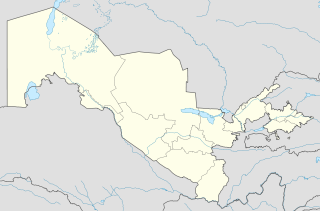
Uzbekistan is divided into 12 regions, 1 autonomous republic, and 1 independent city. Names are given below in the Uzbek language, although numerous variations of the transliterations of each name exist. The regions in turn are divided into 160 districts.
OJSC National Air Company Uzbekistan Airways, operating as Uzbekistan Airways, is the flag carrier airline of Uzbekistan, headquartered in Tashkent. From its hub at Tashkent International Airport, the airline serves a number of domestic destinations; the company also flies international services to Asia, Europe and North America.

The Uzbekistan national football team represents Uzbekistan in association football and is controlled by the Uzbekistan Football Association, the governing body for football in Uzbekistan. Uzbekistan's home ground is Milliy Stadium in Tashkent and their current head coach is Héctor Cúper. Uzbekistan has never qualified to the final stages of the World Cup, but the team have qualified to every AFC Asian Cup since its declaration of independence. In the Asian Cup in 2011, the Uzbekistan national team reached the semi-finals of the tournament. Uzbekistan won the Gold Medal in the football tournament at the Asian Games 1994 in Japan, and was runner-up in the Afro-Asian Cup of Nations in 1995.

UTC+05:00 is an identifier for a time offset from UTC of +05:00. This time is used in:

Islam Karimov Tashkent International Airport is the main international airport of Uzbekistan and the 3rd busiest airport in Central Asia. It is located 12 km (7.5 mi) from the center of Tashkent.

The Uzbekistan Football Association is the governing body of football in Uzbekistan, controlling the Uzbekistan national team.

Uzbek cuisine shares the culinary traditions of Turkic peoples across Central Asia. There is a great deal of grain farming in Uzbekistan, so breads and noodles are of importance, and Uzbek cuisine has been characterized as "noodle-rich". Mutton is a popular variety of meat due to the abundance of sheep in the country and it is a part of various Uzbek dishes.
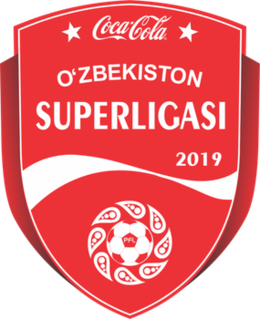
Uzbekistan Super League, also called Coca-Cola Uzbekistan Super League due to sponsorship by Coca-Cola, is the top division of football in Uzbekistan, and is operated under the auspices of the Uzbekistan Professional Football League and Uzbekistan Football Association. It was founded in 1992 and is participate by 12 teams. The top three teams get a chance to compete in the AFC Champions League, while the two last ranked teams are relegated to the Uzbekistan Pro League.

Navbahor District is a district of Navoiy Region in Uzbekistan. The capital lies at Beshrabot.
The Uzbekistan national U-23 football team represents Uzbekistan in international U-23, U-22 football competitions. It is controlled by the Uzbekistan Football Federation and is a member of the Asian Football Confederation.
The 2005 Andijan Unrest occurred when Uzbek Interior Ministry (MVD) and National Security Service (SNB) troops fired into a crowd of protesters in Andijan in the Republic of Uzbekistan on 13 May 2005. Estimates of those killed on 13 May range from 187, the official count of the government, to several hundred. A defector from the SNB alleged that 1,500 were killed. The bodies of many of those who died were allegedly hidden in mass graves following the massacre.
This is a list of football games played by the Uzbekistan national football team between 2010 and 2019.


